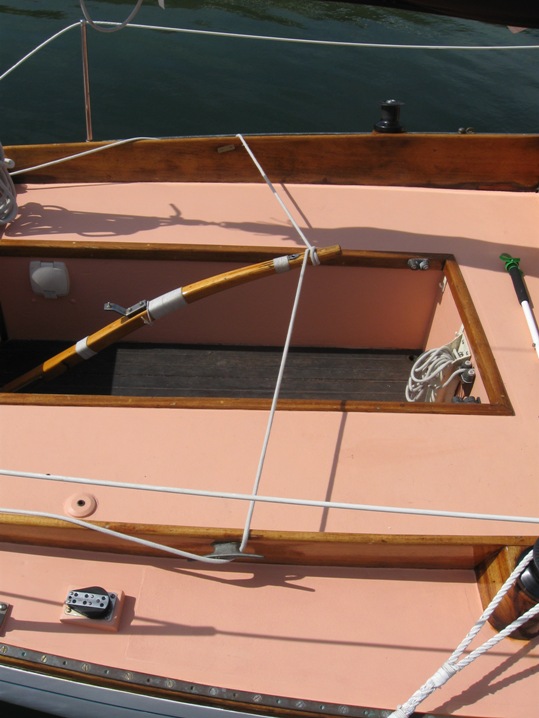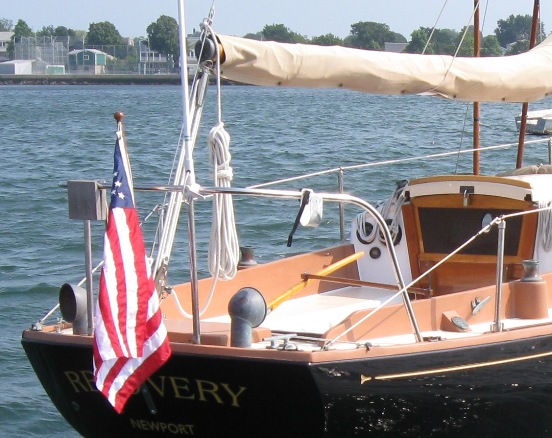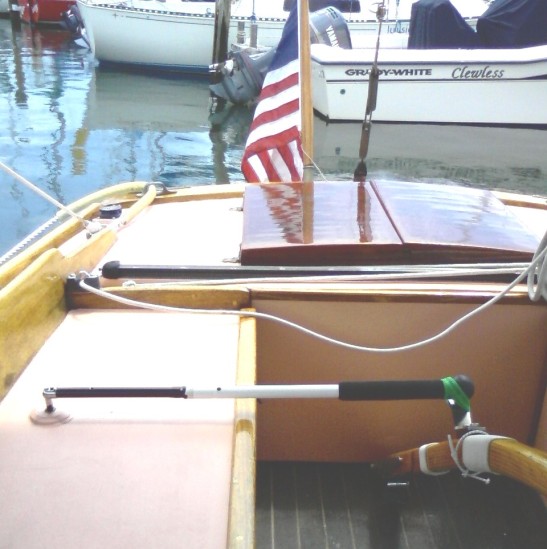|
July 27, 2010 - For maybe 30 years now I have had tiller steered boats, and I always tied off the tiller using a short piece of line. Before that I had wheel steered boats that had a convenient wheel lock built into the system.

|
In the case of Marionette, I use the endless traveller contol line (above) , wrapped with a hitch around the centered tiller and then secured to cleats on either side of the cockpit. Worked well, except sometimes my hitch slips when I don't tie it right.
That little raised circular detent lower left in the above picture is the receptacle for the anchor end of the Autohelm, pictured at left. Note that my tiller extension has a 'ready for use' resting place on top of the tiller, held in place by a loop of shock cord that resides 'permanently' on the tiller. Its just visible ahead of the ball of the tiller extension in the picture at left, and just ahead of the Autohelm tiller bracket in the picture above - its the little things that count! Ok, what's the rest of the story?
|
On July 16, 2010, on a, too short, 4 day, Marionette cruise to Newport, I visited with Jay Picotte whose Tripp Recovery is on a mooring in the harbor off the International Yacht Restoration School. We were in his Tripp built, restored/rebuilt center console Angler 22, Waterlilly, and motored out to see Recovery, and take a couple of pictures. Jay pointed out his tiller lock system. Zooming in, the tiller lock is below.

That simple little varnished wood bar has fittings that duplicate the fittings on his Autohelm. Voila! How come I didn't think of that?
So, on the 10 hour trip motor sailing back home I thought about this tiller lock thing. I have, and use regularly, a tiller extension that does not adjust for length. My two previous tiller extensions ended up useless as the twist lock feature failed when I really needed a usable tiller extension. I vowed not buy another adjustable one and bought a fixed length replacement.
I had modified one of the useless tiller extensions by drilling a couple of holes through both tubes and used a fast pin to lock the tiller extension into one of 3 different configurations. But, I was always losing that fast pin so both extensions sat in my "save, do not throw away, overfilled" parts box in the cellar.
I'm sure you can guess where this is going.

|
I drilled a new hole through the extention at the point that held the tiller in the centered position. Then a short bolt and nut, no fast pin! The universal joint pin on one end of these tiller extensions is about the same size as the Autohelm pin that fits into the cockpit seat socket. One wrap of electrical tape around the pin makes it a nice, snug, press fit. I drilled a small hole in the black rubber ball the size of the pin on the Tiller Autohelm bracket - and pressed the ball on the pin. The green 'tape' is actually a velcro strap that one gets in the supermarket wrapped around the aspargas, or broccoli, sometimes the lettuce. My wife uses them to strap long stemmed flowers in the garden to stakes.
Well, its not varnished wood, and the colors clash, and the velcro strap is a bit hokey, but its cost was $0. And I now have unused traveller line that I have to coil up.
That traveller line system has a lot going for it - but its not neat varnished wood - I am going to have to think about this some more....
|
********************************
October 31, 2011. Dario Rubinsky's Breeze, a Blue Yankee Dolphin, Hull # 83 at Marina del Rey, California has a "tiller tamer". Back on June 24 Dario sent in some pictures and a description of a tiller control line system he uses (edited). As your webmaster was fully engaged in a Maine cruise effort this was posted on Breeze's page but failed getting posted in this Technical Section. Here is Dario's email and pictures.
Hi Ron,
I thought this may help others - it helps me a lot. I sail mostly alone, and like to troll a fishing line, so when the bite happens, I heave to ,fix the tiller and I am fishing, stopped, in a matter of seconds. Also it helps when I am alone and need to reef, and when I need to heave to. I usually sail with the outboard in the well, and with this system, and using the outboard as a trim tab (when needed) I can let Breeze take care of me, and enjoy.

It's a continuous tiller stopper - it allows me to fix the tiller in any position desired (and height too with a single action by pulling the line, at the center), and to undo, by releasing the line at the two cleats. As a result of the triangle that the line makes, it also solved an uncomfortable problem that I usually had, the tangling of the main sheet behind the tiller rudder connection. Because of this set up the main sheet is always in front of it .
The two little lines inside the triangle are elastic and serve the purpose of giving some tension to the continuous line so it keeps tight when not using it.
I am trying to put this idea in the open because it solved many little problems that were there with the other systems offered., I read an article which suggested that instead of the well known approach to man overboard (the figure 8), doing a "Heave To" will serve the purpose of rescuing with less time and more efficacy. I went out and practiced the maneuver, realizing that to fix the tiller after heaving to, will make me take my eyes of the fallen, and also take some precious time I can use for the rescue.
This same problem shows up when reacting to a bite when trolling for a fish and the bite happens - it requires attending to the tying of the tiller system (tiller tamer), and in the meantime, you are dragging the fish. Once the tiller is fixed in any given position, to make a correction, will require untying and retying again with more time and inconvenience.
Dario
*****************************
David LeMestre's Davarsa, a Falcon 24 in Brittany, France has the following system.
To control and " drive " DAVARSA , it's a manual pilot
******************************
|
|
